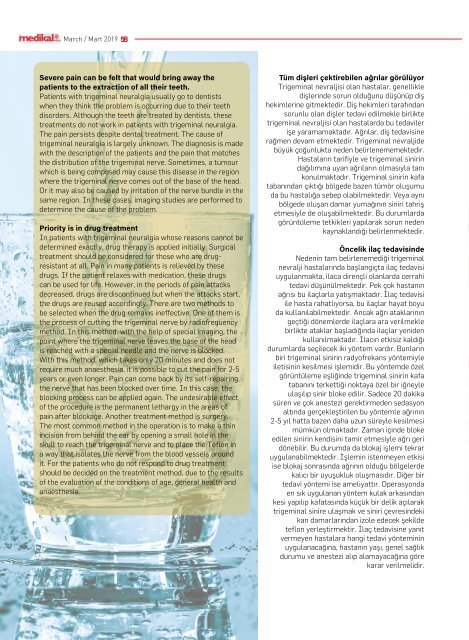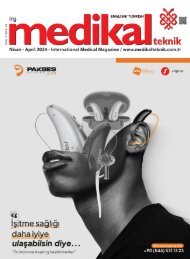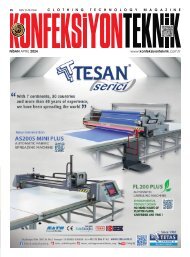Medikal Teknik Mart 2019
Medikal Teknik Mart 2019
Medikal Teknik Mart 2019
You also want an ePaper? Increase the reach of your titles
YUMPU automatically turns print PDFs into web optimized ePapers that Google loves.
March / <strong>Mart</strong> <strong>2019</strong> 58<br />
Severe pain can be felt that would bring away the<br />
patients to the extraction of all their teeth.<br />
Patients with trigeminal neuralgia usually go to dentists<br />
when they think the problem is occurring due to their teeth<br />
disorders. Although the teeth are treated by dentists, these<br />
treatments do not work in patients with trigeminal neuralgia.<br />
The pain persists despite dental treatment. The cause of<br />
trigeminal neuralgia is largely unknown. The diagnosis is made<br />
with the description of the patients and the pain that matches<br />
the distribution of the trigeminal nerve. Sometimes, a tumour<br />
which is being composed may cause this disease in the region<br />
where the trigeminal nerve comes out of the base of the head.<br />
Or it may also be caused by irritation of the nerve bundle in the<br />
same region. In these cases, imaging studies are performed to<br />
determine the cause of the problem.<br />
Priority is in drug treatment<br />
In patients with trigeminal neuralgia whose reasons cannot be<br />
determined exactly, drug therapy is applied initially. Surgical<br />
treatment should be considered for those who are drugresistant<br />
at all. Pain in many patients is relieved by these<br />
drugs. If the patient relaxes with medication, these drugs<br />
can be used for life. However, in the periods of pain attacks<br />
decreased, drugs are discontinued but when the attacks start,<br />
the drugs are reused accordingly. There are two methods to<br />
be selected when the drug remains ineffective. One of them is<br />
the process of cutting the trigeminal nerve by radiofrequency<br />
method. In this method, with the help of special imaging, the<br />
point where the trigeminal nerve leaves the base of the head<br />
is reached with a special needle and the nerve is blocked.<br />
With this method, which takes only 20 minutes and does not<br />
require much anaesthesia, it is possible to cut the pain for 2-5<br />
years or even longer. Pain can come back by its self-repairing<br />
the nerve that has been blocked over time. In this case, the<br />
blocking process can be applied again. The undesirable effect<br />
of the procedure is the permanent lethargy in the areas of<br />
pain after blockage. Another treatment method is surgery.<br />
The most common method in the operation is to make a thin<br />
incision from behind the ear by opening a small hole in the<br />
skull to reach the trigeminal nerve and to place the Teflon in<br />
a way that isolates the nerve from the blood vessels around<br />
it. For the patients who do not respond to drug treatment<br />
should be decided on the treatment method, due to the results<br />
of the evaluation of the conditions of age, general health and<br />
anaesthesia.<br />
Tüm dişleri çektirebilen ağrılar görülüyor<br />
Trigeminal nevraljisi olan hastalar, genellikle<br />
dişlerinde sorun olduğunu düşünüp diş<br />
hekimlerine gitmektedir. Diş hekimleri tarafından<br />
sorunlu olan dişler tedavi edilmekle birlikte<br />
trigeminal nevraljisi olan hastalarda bu tedaviler<br />
işe yaramamaktadır. Ağrılar, diş tedavisine<br />
rağmen devam etmektedir. Trigeminal nevraljide<br />
büyük çoğunlukta neden belirlenememektedir.<br />
Hastaların tarifiyle ve trigeminal sinirin<br />
dağılımına uyan ağrıların olmasıyla tanı<br />
konulmaktadır. Trigeminal sinirin kafa<br />
tabanından çıktığı bölgede bazen tümör oluşumu<br />
da bu hastalığa sebep olabilmektedir. Veya aynı<br />
bölgede oluşan damar yumağının siniri tahriş<br />
etmesiyle de oluşabilmektedir. Bu durumlarda<br />
görüntüleme tetkikleri yapılarak sorun neden<br />
kaynaklandığı belirlenmektedir.<br />
Öncelik ilaç tedavisinde<br />
Nedenin tam belirlenemediği trigeminal<br />
nevralji hastalarında başlangıçta ilaç tedavisi<br />
uygulanmakta, ilaca dirençli olanlarda cerrahi<br />
tedavi düşünülmektedir. Pek çok hastanın<br />
ağrısı bu ilaçlarla yatışmaktadır. İlaç tedavisi<br />
ile hasta rahatlıyorsa, bu ilaçlar hayat boyu<br />
da kullanılabilmektedir. Ancak ağrı ataklarının<br />
geçtiği dönemlerde ilaçlara ara verilmekle<br />
birlikte ataklar başladığında ilaçlar yeniden<br />
kullanılmaktadır. İlacın etkisiz kaldığı<br />
durumlarda seçilecek iki yöntem vardır. Bunların<br />
biri trigeminal sinirin radyofrekans yöntemiyle<br />
iletisinin kesilmesi işlemidir. Bu yöntemde özel<br />
görüntüleme eşliğinde trigeminal sinirin kafa<br />
tabanını terkettiği noktaya özel bir iğneyle<br />
ulaşılıp sinir bloke edilir. Sadece 20 dakika<br />
süren ve çok anestezi gerektirmeden sedasyon<br />
altında gerçekleştirilen bu yöntemle ağrının<br />
2-5 yıl hatta bazen daha uzun süreyle kesilmesi<br />
mümkün olmaktadır. Zaman içinde bloke<br />
edilen sinirin kendisini tamir etmesiyle ağrı geri<br />
dönebilir. Bu durumda da blokaj işlemi tekrar<br />
uygulanabilmektedir. İşlemin istenmeyen etkisi<br />
ise blokaj sonrasında ağrının olduğu bölgelerde<br />
kalıcı bir uyuşukluk oluşmasıdır. Diğer bir<br />
tedavi yöntemi ise ameliyattır. Operasyonda<br />
en sık uygulanan yöntem kulak arkasından<br />
kesi yapılıp kafatasında küçük bir delik açılarak<br />
trigeminal sinire ulaşmak ve siniri çevresindeki<br />
kan damarlarından izole edecek şekilde<br />
teflon yerleştirmektir. İlaç tedavisine yanıt<br />
vermeyen hastalara hangi tedavi yönteminin<br />
uygulanacağına, hastanın yaşı, genel sağlık<br />
durumu ve anestezi alıp alamayacağına göre<br />
karar verilmelidir.

















